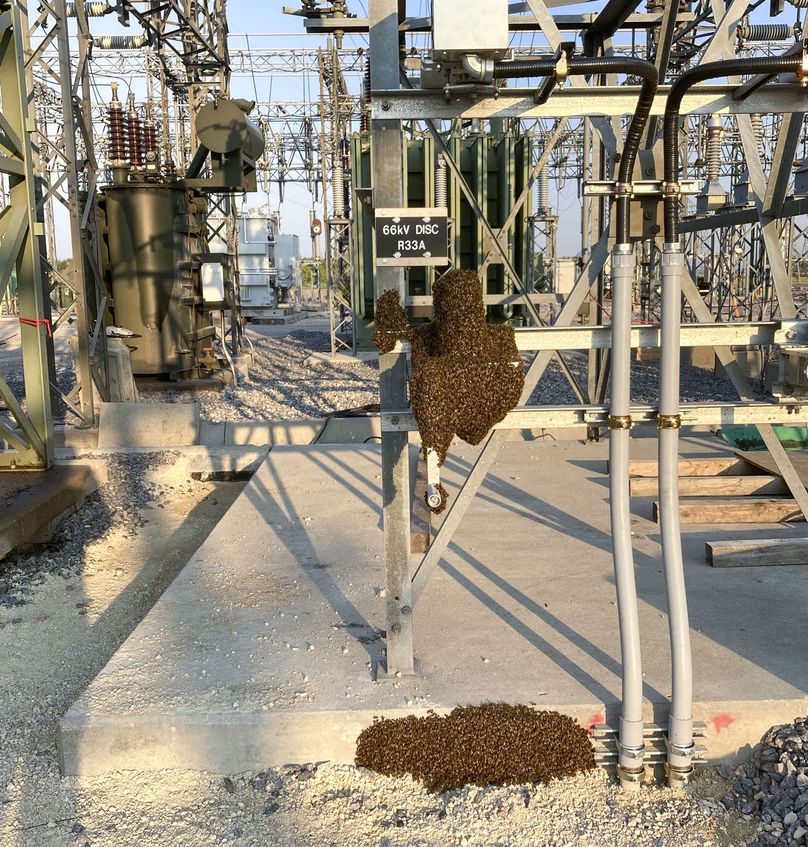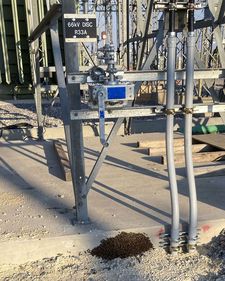
A swarm of honeybees on a switch at Rosser Station.
Enlarge image: A swarm of honeybees on a switch in an electrical substation.
Rain, snow, sleet, heat – field staff deal with a lot of obstacles from mother nature on the job. This time it was honeybees.
Earlier this summer, a construction crew went to test breakers at Rosser Station and came across a huge swarm of honeybees making a home in the station.
The four-person crew, made up of Don Blois, Mitch Hince, John Schroeder and Kurtis Dyck, took a minute to step back and discuss the risks.
“When we test breakers, they shake and shudder – they’re really loud and could disturb the bees. Also, one of the guys on our crew is allergic (to bee stings),” said Don.
“We knew our crew would probably be safe for the remaining time of the first day if we kept clear and didn’t bother them, so we produced a plan for the bee swarm if they were still there in the morning.”
The crew got in touch with a local beekeeper, Chris Bartel, who came out the next morning at on his own accord to assist. Chris skillfully collected the remaining bees in a box and brought them back to assimilate with a hive on his own apiary – Bartel Honey Farms in Oakbank.

The next morning, much of the swarm on the switch at Rosser Station had flown away, but a pile of bees remained on the ground.
Enlarge image: A pile of bees on the ground in an electrical substation.
Why did the bees land on the switch at Rosser Station?
Chris explains: A few days before a new honeybee queen is going to hatch in a hive, the hive splits – the worker bees herd the old queen away from the hive so the new queen can hatch without another queen in her presence. If two queens are present in the same hive, they would fight to the death.
The split hive and their queen decided to land on the switch in Rosser Station. In these swarm situations, the bees tend to only land in one place for 24 to 48 hours before seeking a more permanent home, so by the time Chris arrived the next morning, most of the bees were gone. Only those on the ground under the switch were left behind, and the queen had flown away.
“Some of the bees didn’t get the bugle call in the morning that they were leaving, and that’s what I cleaned up,” said Chris. “The leftover bees at the station didn’t have a queen so they would have died off or just gone to find a new colony if they weren’t taken.”
To collect the leftover bees at the station, Chris opened a box and scooped handfuls of bees into it. The bees inside the box found it to be a safe location so they started “fanning” – communicating by pheromones – they sent out the “come here” scent and the rest of the bees in the station started to walk over and join the bees in the box. As each bee entered the box, they stopped to fan so that the smell is sent to the bees behind them and it is communicated as a good location.
Chris also used a vacuum to collect bees. When he pulled out the vacuum, he realized he had forgotten the battery for the vacuum at home, but it coincidentally needed the same battery as a power tool that the Hydro crew was using, so they were able to lend him a battery.
Once the bees made it into the box, Chris brought them back to his own apiary to assimilate with another hive.
“I think I only got stung twice,” said Chris.
If you’d like to dive deeper into how we dealt with the honeybee swarm in our station, Chris also documented the story on his YouTube channel.



